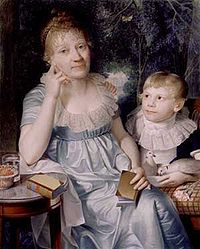
Benedikte Naubert
Encyclopedia

Historical novel
According to Encyclopædia Britannica, a historical novel is-Development:An early example of historical prose fiction is Luó Guànzhōng's 14th century Romance of the Three Kingdoms, which covers one of the most important periods of Chinese history and left a lasting impact on Chinese culture.The...
s, and is considered a pioneer of the genre in the 1780s. Today she is largely unknown, even in Germany.
She was born in Leipzig
Leipzig
Leipzig Leipzig has always been a trade city, situated during the time of the Holy Roman Empire at the intersection of the Via Regia and Via Imperii, two important trade routes. At one time, Leipzig was one of the major European centres of learning and culture in fields such as music and publishing...
. The daughter of a professor of medicine who died in December 1757, she received from her mother and half-brother, a professor of theology, a thorough education in philosophy, history, Latin, and Greek, and learned to play the piano and harp. She began writing early, but her work did not appear until 1785, with The Story of Emma, Daughter of Charlemagne, which concerns the legend of Einhard
Einhard
Einhard was a Frankish scholar and courtier. Einhard was a dedicated servant of Charlemagne and his son Louis the Pious; his main work is a biography of Charlemagne, the Vita Karoli Magni, "one of the most precious literary bequests of the early Middle Ages."-Public life:Einhard was from the eastern...
's elopement with the fictional Emma. It was widely imitated.
Nearly all her books were published anonymously, through the agency of her half-brother, and the scholarship they displayed prompted speculation as to their author. Several men were suspected, among them Johann Friedrich Wilhelm Müller. Against her will, in 1817 her identity was revealed in an article in the Zeitung für die elegante Welt. Her next book, Rosalba (1817) bore her true name for the first time. She died in 1819 in Leipzig, where she had travelled for an eye operation.
She was married twice, first in 1797 to the Naumberg merchant Lorenz Wilhelm Holderrieder, and after his death in 1800 to Johann Georg Naubert, also a merchant.
Her historical novels were occasionally translated into French and English, and she herself also translated books from those languages. In Ulrich Holzer or Walter von Montbarry she employs the technique of focusing attention on a fictional character, or a person of minor historical significance, and witnessing events through his eyes — a technique borrowed by Scott, who had read her work in translation.
Her collection of folk-tales, Neuen Volksmärchen der Deutschen (1789–1793; last ed. 2001) predates that of the Brothers Grimm
Brothers Grimm
The Brothers Grimm , Jacob Grimm and Wilhelm Grimm , were German academics, linguists, cultural researchers, and authors who collected folklore and published several collections of it as Grimm's Fairy Tales, which became very popular...
(1806), but it consists of Kunstmärchen, free adaptations of old stories, rather than faithful transcriptions. They are comparable to those of Johann Karl August Musäus
Johann Karl August Musaus
Johann Karl August Musäus was a German author from Jena. He studied theology at the university of Jena, and would have become the pastor of a parish but for the resistance of some peasants, who objected that he had been known to dance.From 1760–62 Musäus published in three volumes his first...
.
A monograph by Hilary Brown on Naubert's study of and influence on English literature was published in 2005. http://www.maney.co.uk/search?fwaction=show&fwid=653

